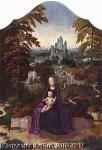Adriaen Isenbrant
Adriaen Isenbrant
Place: Haarlem
Born: 1580
Death: 1551
Biography:
Adriaen Isenbrandt or Adriaen Ysenbrandt was a Northern Renaissance painter. Documentary evidence suggests he was a significant artist of his period, even though no specific works by his hand are clearly documented. Art historians have conjectured that he operated a large workshop specializing in religious subjects and devotional paintings, which were executed in a conservative style in the tradition of Early Netherlandish painting. He was believed by Georges Hulin de Loo to be the same person as the anonymous Master of the Seven Sorrows of the Virgin or Pseudo-Mostaert. Other art historians doubt that any works can be reliably attributed to him, and the number of paintings attributed to him by major museums has been in decline for many decades.
There are only a few documentary records of his life, and some mentions in literature from the artist's lifetime or soon after. Even so there are no documents which link him as the creator of any surviving works. It is possible that he was born in Haarlem or Antwerp around 1490. It is not known where or with which painter he served his apprenticeship.
He is named for the first time in 1510, when he came to Bruges and bought his burghership. In November of the same year he became master in the local painters' Guild of St. Luke and the goldsmiths' guild of St. Elooi. He was later elected nine times as a "deacon" (in Old Dutch : vinder) and twice as the governor (in Old Dutch : gouverneur = treasurer) of the guild.
He quickly established an important workshop, probably in the Korte Vlaminckstraat in Bruges. This was close to the workshop of Gerard David, at the Vlamijncbrugghe and the former workshop of Hans Memling. Bruges, at that time, was one of the richest towns in Europe. Rich traders and merchants ordered diptychs and portraits for personal use. Isenbrandt painted mainly for private clients. However, there were some paintings that were created without any particular commission. He had enough work to even put out work to other painters in Bruges, as a legal suit from 1534 by Isenbrandt against Jan van Eyck (not the famous one) for non-delivery of paintings he had ordered, demonstrates. He was also appointed the agent in Bruges of the painter Adriaan Provoost (son of Jan Provoost), who had moved to Antwerp in 1530. Contemporary sources therefore mention Isenbrandt as a famous and well-to-do painter.
He married twice, the first time with Maria Grandeel, daughter of the painter Peter Grandeel. They had one child. After her death in 1537, he married again with Clementine de Haerne with whom he was married by 1543. This second marriage resulted in two daughters and a son. He also had an extramarital daughter with the innkeeper Katelijne van Brandenburch (who was at the same the mistress of the painter Ambrosius Benson).
When he died, at Bruges, in 1551, he was buried alongside his first wife at the cemetery of the St. Jacob church there; his children inherited no less than four houses with surrounding property.
Along with Albert Cornelis (before 1513–1531) and Ambrosius Benson (before 1518–1550), a painter from Lombardy, he worked in the workshop of Bruges' leading painter Gerard David, while he was already a master at that time. Isenbrandt is mentioned in the book De Gandavensibus et Brugensibus eruditionis laude claris libri duo by the priest Antonius Sanderus, published in Amsterdam in 1624. This writer refers to texts of the Florentine Lodovico Guicciardini, the Schilderboeck of Karel van Mander and the (lost) notes of the Ghent jurist Dionysius Hardwijn (or Harduinus, 1530–1604). The latter, who had spent several years in Bruges about 1550, mentions Isenbrandt as a disciple of the old Gerard David, who excelled "in nudes and in portraits". He may have travelled to Genoa in 1511 together with Joachim Patinir and Gerard David. The influence of Gerard David shows clearly in the composition and the landscape background of the works attributed to Isenbrandt.
In his critical exhibition catalogue of Early Flemish Masters in Bruges in 1902, the Ghent great connoisseur of early Flemish Art and art historian Georges Hulin de Loo, came to the conclusion that Isenbrandt was actually the anonymous Master of the Seven Sorrows of the Virgin and the author of a large body of paintings previously attributed to Gerard David and Jan Mostaert by the German art historian Gustav Friedrich Waagen. He is therefore sometimes called the Pseudo-Mostaert. Even if this attribution to Isenbrandt cannot be proven without doubt, it is now generally accepted by some art historians, although many others regard Isenbrandt as a convenient label for a body of work by many different artists.
No surviving painting can be firmly documented as by Isenbrandt. A document stating that he sent some paintings from Antwerp to Spain shows that worked for export as well as the local market, and suggests his international reputation. Two paintings usually associated with him are dated, both in 1518 :
More...
Wikipedia link: Click Here














